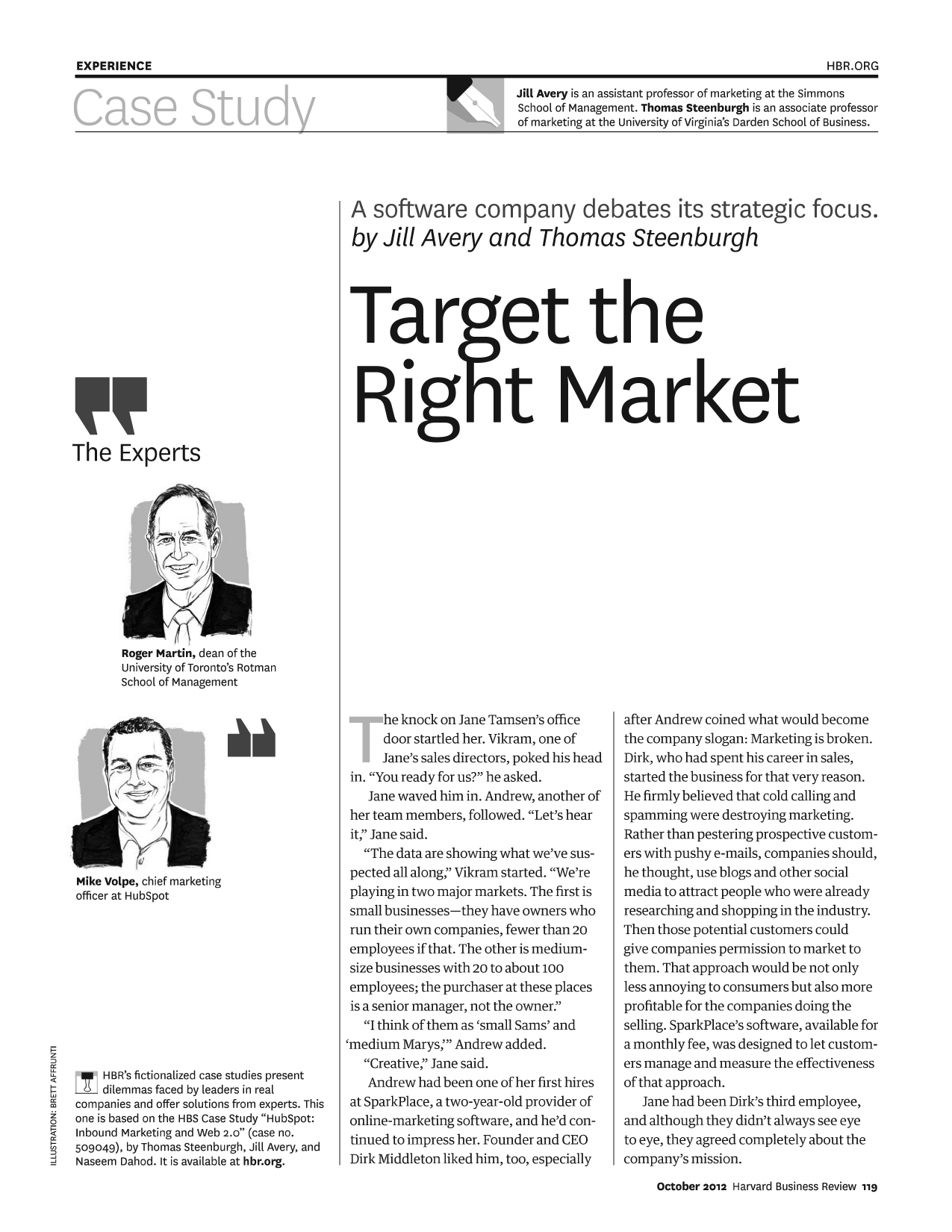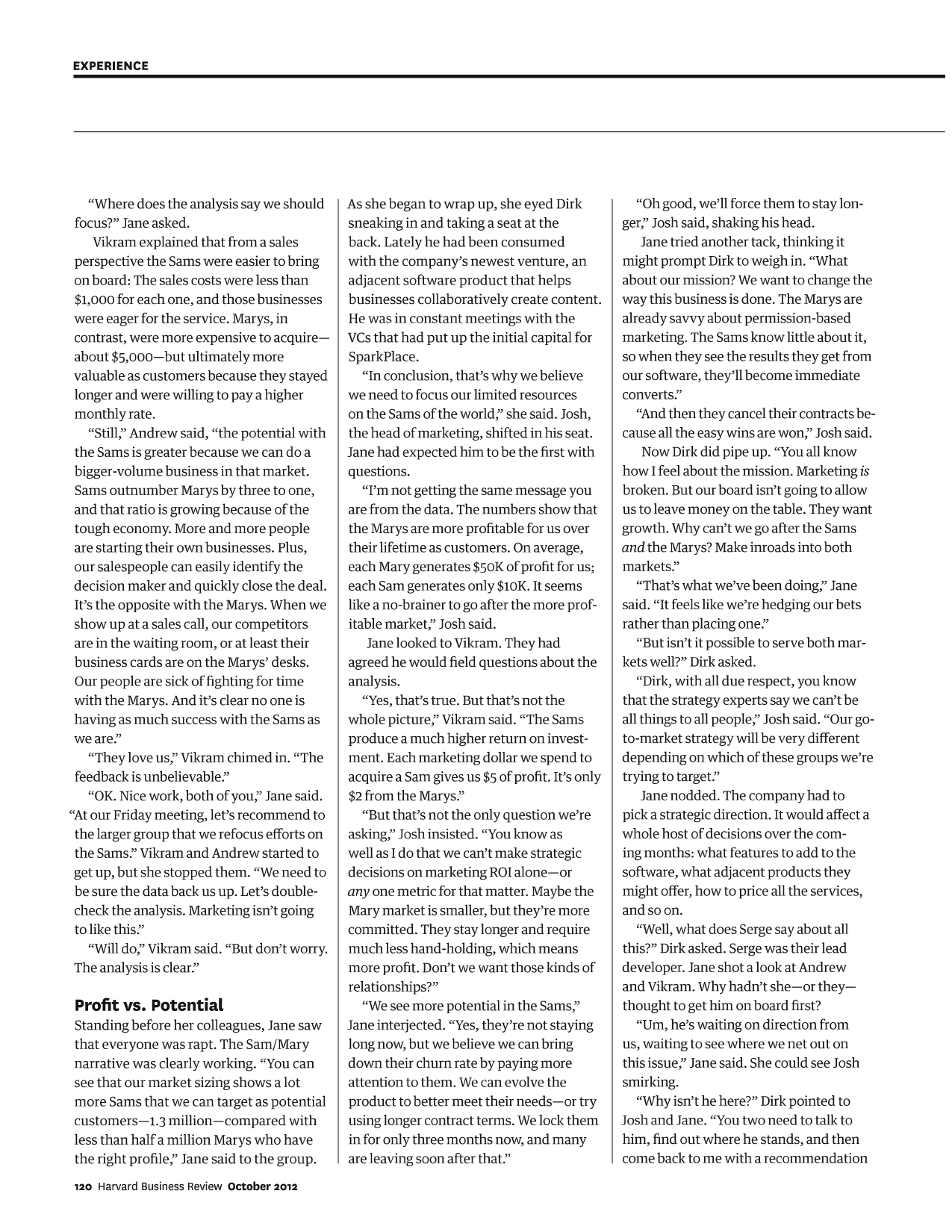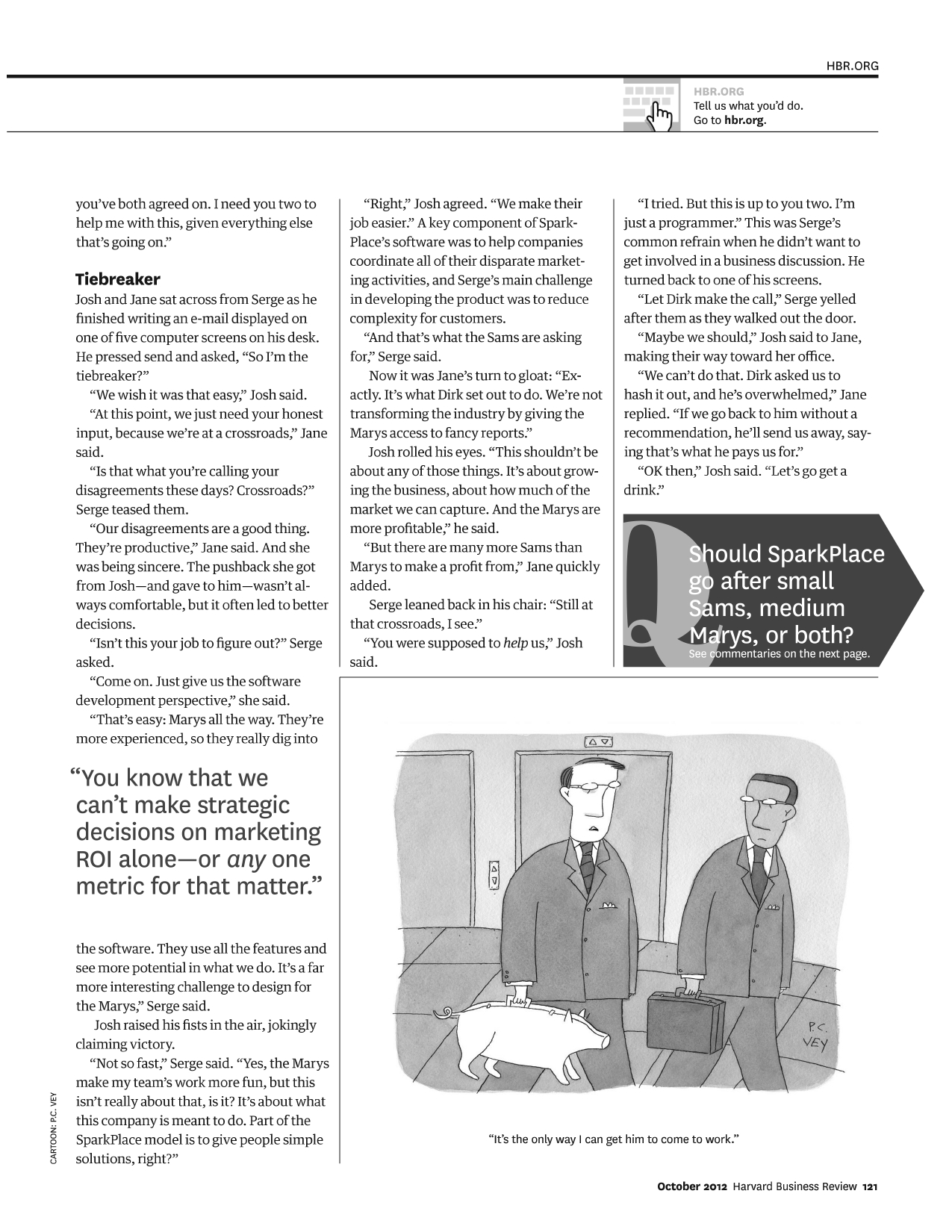I Need to understand the below qustions and solve them.
1:What type of segmentation strategy is used by the company in the case study?
2: designa sales strategy for the company in the case, In your sales strategy design
segmentation, positioning, and target market for this company.
3:Describe the customer value proposition of the company.
EXPERIENCE HBR.ORG Case Study Jill Avery is an assistant professor of marketing at the Simmons School of Management. Thomas Steenburgh is an associate professor of marketing at the University of Virginia's Darden School of Business. A software company debates its strategic focus. by Jill Avery and Thomas Steenburgh Target the The Experts Right Market Roger Martin, dean of the University of Toronto's Rotman School of Management he knock on Jane Tamsen's office after Andrew coined what would become loor startled her. Vikram, one of the company slogan: Marketing is broken. Jane's sales directors, poked his head Dirk, who had spent his career in sales, in. "You ready for us?" he asked. started the business for that very reason. Jane waved him in. Andrew, another of He firmly believed that cold calling and her team members, followed. "Let's hear spamming were destroying marketing. it," Jane said. Rather than pestering prospective custom- 'The data are showing what we've sus- ers with pushy e-mails, companies should, Mike Volpe, chief marketing pected all along," Vikram started. "We're he thought, use blogs and other social officer at HubSpot playing in two major markets. The first is media to attract people who were already small businesses-they have owners who researching and shopping in the industry. run their own companies, fewer than 20 employees if that. The other is medium- Then those potential customers could give companies permission to market to size businesses with 20 to about 100 them. That approach would be not only employees; the purchaser at these places less annoying to consumers but also more is a senior manager, not the owner." profitable for the companies doing the "I think of them as 'small Sams' and selling. SparkPlace's software, available for ILLUSTRATION: BRETT AFFRUNTI 'medium Marys," Andrew added. a monthly fee, was designed to let custom- HBR's fictionalized case studies present 'Creative," Jane said. ers manage and measure the effectiveness dilemmas faced by leaders in real Andrew had been one of her first hires of that approach. companies and offer solutions from experts. This ne is based on the HBS Case Study "HubSpot: at SparkPlace, a two-year-old provider of Jane had been Dirk's third employee, Inbound Marketing and Web 2.0" (case no. online-marketing software, and he'd con- and although they didn't always see eye 509049), by Thomas Steenburgh, Jill Avery, and tinued to impress her. Founder and CEO to eye, they agreed completely about the Naseem Dahod. It is available at hbr.org. Dirk Middleton liked him, too, especially company's mission. October 2012 Harvard Business Review 119EXPERIENCE \"where does the analysis say we should focus?\" Jane asked. Vikram explained that from a sales perspective the Sams were easier to bring on board: The sales costs were less than $1,000 for each one, and those businesses were eager for the service. Marys, in contrast, were more expensive to acquire about $5,000 but ultimately more valuable as customers because they stayed longer and were willing to pay a higher monthly rate. \"Still,\" Andrew said, \"the potential with the Sams is greater because we can do a bigger-volume business in that market. Sams outnumber Marys by three to one, and that ratio is growing because of the tough economy. More and more people are starting their own businesses. Plus, our salespeople can easily identify the decision maker and quickly close the deal. it's the opposite with the Marys. When we show up at a sales call, our competitors are in the waiting room, or at least their business cards are on the Marys' desks. Our people are sick of ghting for time with the Marys. And it's clear no one is having as much success with the Sams as we are.\" \"They love us,\" Vikram chimed in. \"The feedback is unbelievable.\" \"0K. Nice work, both of you,\" Jane said. \"At our Friday meeting, let's recommend to the larger group that we refocus efforts on the Sams.\" Vikram and Andrew started to get up, but she stopped them. \"We need to be sure the data back us up. Let's double- check the analysis. Marketing isn't going to like this.\" \"Will do,\" Vikram said. \"But don't worry. The analy5is is clear.\" Prot vs. Potential Standing before her colleagues, Jane saw that everyone was rapt. The Saijary narrative was clearly working. \"You can see that our market sizing shows a lot more Sams that we can target as potential customers1.3 millioncompared with less than half a million Marys who have the right prole,\" Jane said to the group. 120 Harvard Business Review October 2012 As she began to wrap up, she eyed Dirk sneaking in and taking a seat at the back. Lately he had been consumed with the company's newest venture, an adjacent software product that helps businesses collaboratively create content. He was in constant meetings with the VCs that had put up the initial capital for SparkPlace. \"In conclusion, that's why we believe we need to focus our limited resources on the Sams of the world,\" she said. Josh. the head ofmarkeh'ng, shifted in his seat. Jane had expected him to be the rst with questions. \"I'm not getting the same message you are from the data. The numbers show that the Marys are more protable for us over their lifetime as customers. On average, each Mary generates $5 UK of prot for us; each Sam generates only $10K. It seems like a no-brainer to go after the more prof- itable market,\" Josh said. Jane looked to Vikram. They had agreed he would field questions about the analysis. \"Yes, that's true. But that's not the whole picture,\" Vikram said. \"The Sams produce a much higher return on invest- ment. Each marketing dollar we spend to acquire a Sam gives us $5 of prot. It's only $2 from the Marys.\" \"But that's not the only question we're asking,\" Josh insisted. \"You know as well as I do that we can't make strategic decisions on marketing R01 alone or any one metric for that matter. Maybe the Mary market is smaller, but they're more committed. They stay longer and require much less hand-holding, which means more prot. Don't we want those kinds of relationships?\" \"We see more potential in the Barns,\" Jane interjected. \"Yes, tliey're not staying long now, but we believe we can bring down their churn rate by paying more attention to them. We can evolve the product to better meet their needs or try using longer contract terms. We lock them in for only three months now, and many are leaving soon after that.\" \"Oh good, we'll force them to stay lon- ger,\" Josh said, shaking his head. Jane tried another tack, thinking it might prompt Dirk to weigh in. \"What about our mission? We want to change the way this business is done. The Marys are already savvy about permission-based marketing. The Sams know little about it, so when they see the results they get from our software, they'll become immediate converts.\" \"And then they cancel their contracts be- cause all the easy wins are won,\" Josh said. Now Dirk did pipe up. \"You all know how I feel about die mission. Marketing is broken. But our board isn't going to allow us to leave money on the table. They want growth. Why can't we go after the Sams and the Marys? Make inroads into both markets.\" \"That's what we've been doing,\" Jane said. \"It feels like we're hedging our bets rather than placing one.\" \"But isn't it possible to serve both mar- kets well.\" Dirk asked. \"Dirk, with all due respect, you know that the strategy experts say we can't be all things to all people,\" Josh said. \"Our go- to-market strategy will be very different depending on which of these groups we're trying to target.\" Jane nodded. The company had to pick a strategic direction. It would affect a whole host of decisions over the com ing months: what features to add to the software, what adjacent products they might offer, how to price all the services, and so on. \"Well, what does Serge say about all this?\" Dirk asked. Serge was their lead developer. Jane shot alook at Andrew and Vikram. Why hadn't she or they thought to get him on board rst? \"Um, he's waiting on direction from us, waiting to see where we net out on this issue,\" Jane said. She could see Josh smirking. \"Why isn't he here?\" Dirk pointed to Josh and Jane. \"You two need to talk to him, nd out where he stands, and then come back to me with a recommendation HBR.ORG H B Fl .ORG Tell us what you'd do. Go to hbmrg. CARTOON: EC. VE'I' you've both agreed on. i need you two to help me with this, given everything else that's going on.\" Tiebreaker Josh and Jane sat across from Serge as he nished writing an e-mail displayed on one of ve computer screens on his desk. He pressed send and asked, \"So I'm the tiebreaker?\" \"We wish it was that easy,\" Josh said. \"At this point, we just need your honest input, because we're at a crossroads,\" Jane said. \"Is that what you're calling your disagreements these days? Crossroads. \" Serge teased them. \"Our disagreements are a good thing. They're productive,\" Jane said. And she was being sincere. The pushback she got from J oshand gave to himwasn't al- ways comfortable, but it often led to better decisions. \"Isn't this your job to gure out?\" Serge asked. \"Come on. Just give us the software development perspective,\" she said. \"That's easy: Marys all the way. They're more experienced, so they really dig into \"You know that we can't make strategic decisions on marketing ROI aloneor any one metric for that matter.\" the software. They use all the features and see more potential in what we do. It's a far more interesting challenge to design for the Marys,\" Serge said. Josh raised his sts in the air, jokingly claiming victory. \"Not so fast,\" Serge said. \"Yes, the Marys make my team's work more fun, but this isn't really about that, is it? It's about What this company is meant to do. Part of the SparkPiace model is to give people simple solutions, right?\" \"Right,\" Josh agreed. \"We make their job easier.\" A key component of Spark- Place's software was to help companies coordinate all of their disparate market- ing activities, and Serge's main challenge in developing the product was to reduce complexity for customers. \"And that's what the Sams are asking for,\" Serge said. NOW it was Jane's tum to gloat: \"Ex- actly. It's what Dirk set out to do. We're not transforming the industry by giving the Marys access to fancy reports\" Josh rolled his eyes. \"This shouldn't be about any of those things. It's about grow- ing the business, about how much of the market we can capture. And the Marys are more protable,\" he said. \"But there are many more Sams than Marys to make a prot from,\" Jane quickly added. Serge leaned back in his chair: \"Still at that crossroads, I see.\" \"You were supposed to help us,\" Josh said. \"I tried. But this is up to you two. l'm just a programmer.\" This was Serge's common refrain when he didn't want to get involved in a business discussion. He turned back to one of his screens. \"Let Dirk make the call,\" Serge yelled after them as they walked out the door. \"Maybe we should,\" Josh said to Jane, making their way toward her office. \"We can't do that. Dirk asked us to bash it out, and he's overwhelmed," Jane replied. \"If we go back to him without a recommendation, he'll send us away, say- ing that's what he pays us for.\" \"OK then,\" Josh said. \"Let's go get a drink.\" Should SparkPlace go after small Sams, medium Marys, or both?' See cummer' li'l'l [hr- l'llf'Kl \"It's the only way I can get him to dome to work.\" October 201: Harvard Business Review 121









